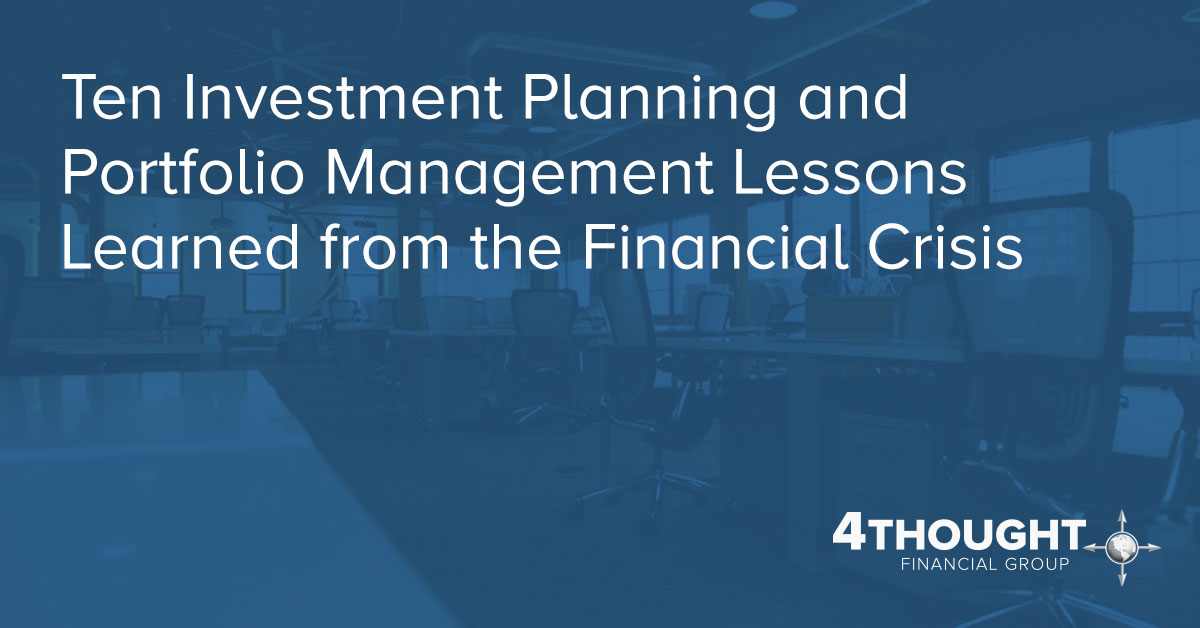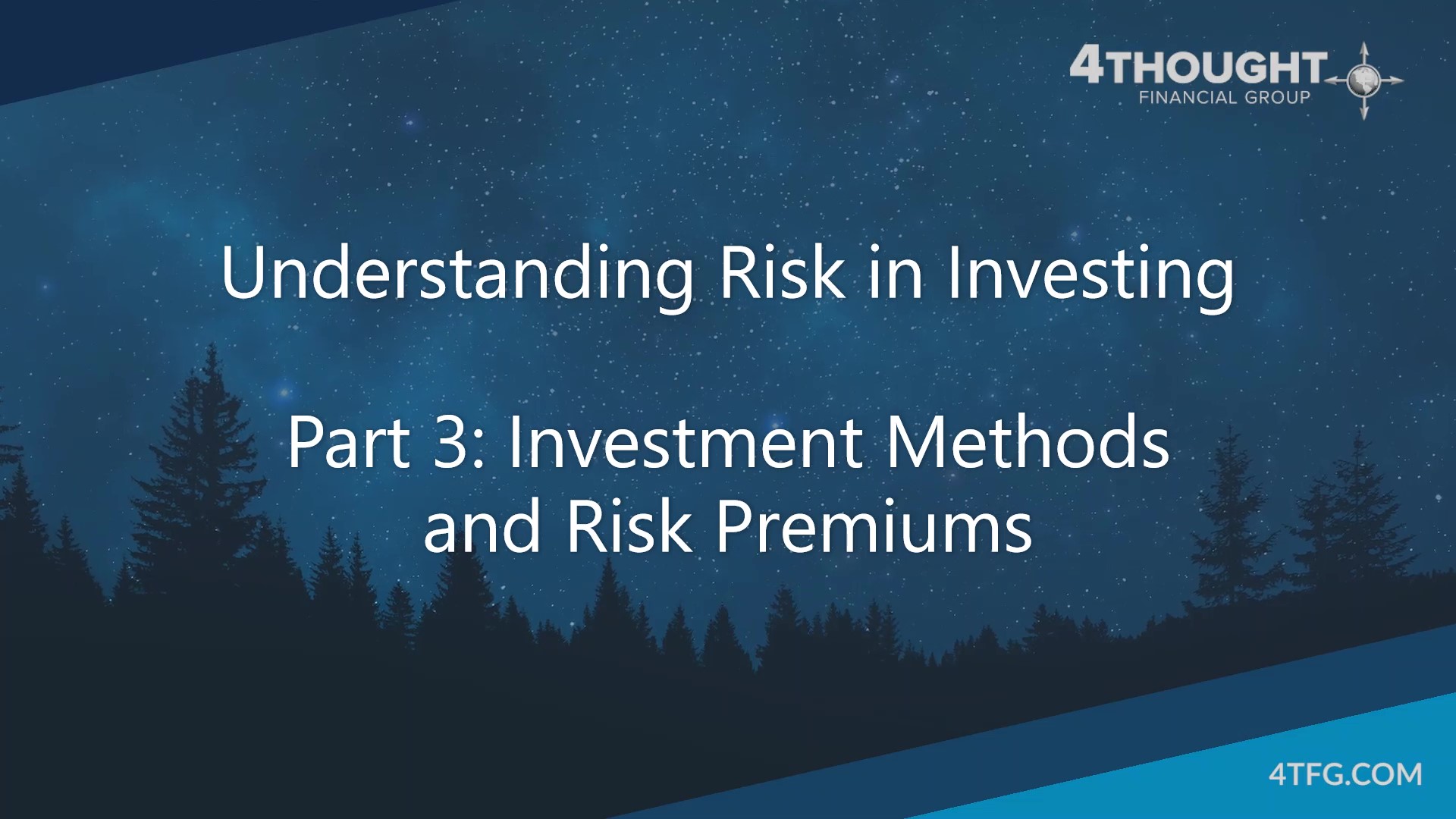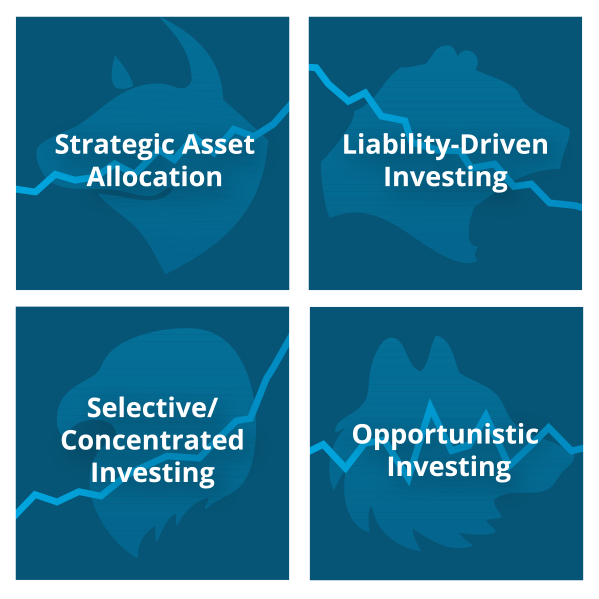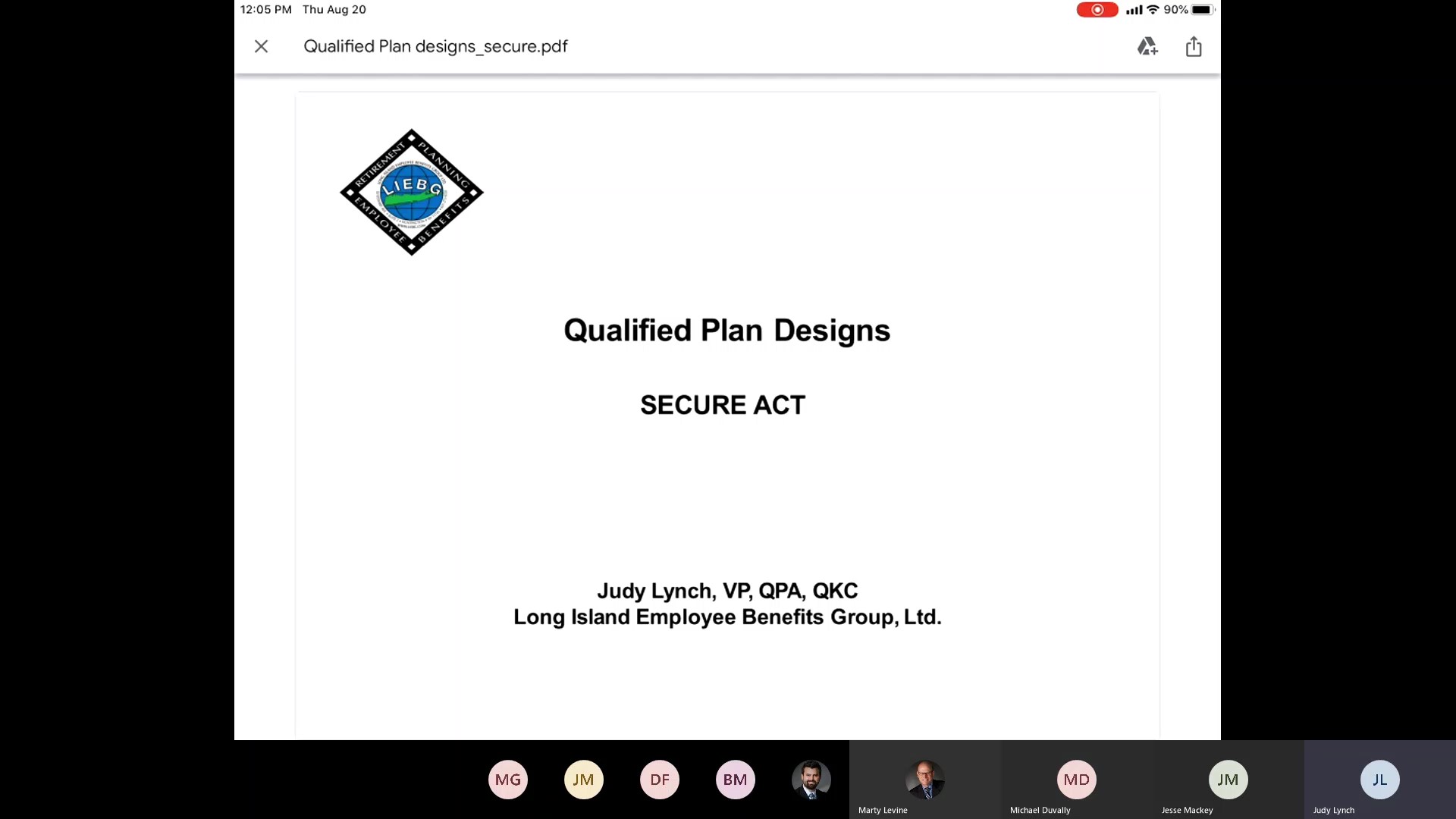
The world’s most recent financial crisis has provided a unique proving ground in which investment planning and investment management firms have tested their mettle on many levels. As the complexities of the crisis continue to emerge, pearls of portfolio management and investment planning wisdom have begun to surface. We will explore ten of these that have so far made themselves apparent. Many of the ideas we will mention here are familiar to veteran advisors, while others may be completely new. On the firm level, 4Thought has utilized the vast majority of these concepts already in the past. However, the severity of the crisis that investors have experienced thus far has highlighted the importance of these practices and reconfirmed the views we previously held. Other ideas illustrated here represent shifts from our past approaches.
While in the past years of relatively easy growth, advisors could have skated by without paying attention to these concepts, the crisis has proven a trial by fire. Those advisors who have adopted certain practices will continue to thrive, while those who have failed to do so (or fail to adapt quickly) will no longer be standing when the financial tidal wave finally recedes from the shores.
If as an organization we continue to adhere to our fire-tested proven principles and preemptively adapt to the continuous onslaught before us, 4Thought will emerge as a stronger firm, well-positioned to serve clients in a manner that exceeds their expectations. As planners, service means that we make sure our clients achieve their goals regardless of fluctuations in the economic environment and of the many risks that will continue to threaten their family’s standard of living as they move through life. We need to ensure that their assets serve them always better. Portfolio performance is part of this service.
What follows is an exploration of ten of the emerging lessons of the financial crisis for investment planning and portfolio management:
***
1. Practice Proper Investment Planning and Utilize Asset/Liability Matching
The first part of the above statement (Practice proper investment planning) is perhaps the most obvious, but is also the least-followed principle in the investment management world that we will discuss. As explored in the December ’08 issue, the process of mapping out an investment plan is generally completely lost on the investing public, who will immediately seek out what they believe is the “best” investment manager, fund, or security without any forethought.
Without professional aid in properly determining goals, assessing risks, determining cash flow needs/constraints, assessing client suitability, and customizing an action plan to achieve the goals set forth, the probability of client satisfaction is next to zero in the long run. This has become clear recently as clients without an outlined definition of their objectives and a plan to reach them are inevitably disenchanted with their portfolio performance because they have no basis on which to judge whether their money will be able to recover in the long run relative to goals. All they see is the short run situation - their portfolio dropping like a rock. The feeling of helplessness at this sight can be alleviated if a plan of action is in place and a determination can be made as to what is required to recover from the fall.
The more direct the match, the greater the likelihood of achieving the goal.
On the other hand, the probability that a well-defined investment plan will be fulfilled can be increased by the use of direct Asset/Liability Matching, as alluded to in the second part of the above statement. Asset/Liability Matching involves piecing together an investment plan so that each risk to the achievement of a certain client objective is directly offset by a corresponding asset or risk management technique. The more direct the match, the greater the likelihood of achieving the goal.
Hypothetically, if it is determined during a financial planning analysis that a client currently has enough assets on a nominal basis to purchase assets to launch a business in five years, but needs to hedge against inflation risk, it may be more prudent to compose a directly matched portfolio of TIPS rather than a stock/bond portfolio. In this case, the client would nearly eliminate the six-year inflation risk, preserve the principal on a real basis, and also take stock/bond market volatility out of the equation. With this more direct match, even if the TIPS decrease in value and the stock market drops precipitously, the client will not care because his/her goal will still be achieved, as the price of the needed business launch assets will theoretically also have dropped with the TIPS. This Asset/Liability matching principle can be applied in many forms when creating an investment plan.
2. Reassess Client Stability Regularly and When Major Market Fluctuations Occur
Given the havoc that the financial crisis continues to wreak throughout the economy, many clients are being dramatically affected beyond the drops in their portfolio values - especially business owners. With dramatic changes in cash flow needs for some, it has become ever more important to reassess the objectives towards which portfolios are intended and thus the actual asset allocations within the portfolios. As business earnings and reserves deplete, business owners may be unexpectedly forced to liquidate portfolio holdings in order to meet cash flow needs. As such, their portfolio investment time horizon may have shortened dramatically and it will be necessary to reallocate the portfolio on a much more conservative basis than previously utilized.
In addition, during September and October in particular, it was extremely important to contact all clients to reassess their life situation, portfolio investment time horizons, liquidity/income needs, and risk tolerance to ensure that a proper portfolio allocation was in place and that clients were not taking on any unnecessary risks.
Opportunistic portfolio rebalancing also became important as stocks generally lost value faster than bonds, leaving portfolios bond-heavy. In the event of a market recovery, an unintentional dearth of stock exposure due to a lack of rebalancing would have left such portfolios unable to proportionally regain losses experienced. Therefore it became clear that in addition to regular annual or semi-annual rebalancing, active and opportunistic rebalancing was needed.
3. Perform Independent Due Diligence
After the Madoff scandal, there could not be a clearer lesson than the importance of independent investment due diligence. While 4Thought never endorsed Madoff with any of our clientele (primarily because of a lack of information on the limited partnership program), we do have clients that were severely affected by the Ponzi scheme through purchases made through other advisors. The lack of information available with regards to the one page fabricated statements that Madoff supplied to his “investors” lend credit to Warren Buffett’s tenet that one should not invest in something that one does not understand.
Professional and individual investors alike gave billions of dollars to Madoff on faith and greed alone, without any indication of what was being done with their money. To purists of independent due diligence and analytical-style investing, this is a sickening thought. Rigorous independent due diligence on all investment vehicles utilized in an investment management practice must be performed at the inception of use and regularly thereafter by the overlay portfolio management firm and advisors. Reliance solely on the due diligence of third party organizations is a mistake.
4. Utilize Variable Annuities and Other Guaranteed Products Where Appropriate*
The sour reputation once given to investment products with insurance wrappers, such as Variable Annuities with Guaranteed Income Living Benefit riders and principal protected notes has since been vindicated on many levels over the last year. In particular, VA products with lifetime income guarantee riders have proven themselves as important tools for minimizing the risk associated with entering retirement during a down market. This “point of retirement” risk is mitigated by the ability of such products to provide a guaranteed growth of income benefit amount regardless of the market performance of underlying mutual fund subaccounts. Clients that purchased such products prior to the 2007-2008 market debacle may now have the ability to retire as planned, whereas their counterparts that did not purchase such products may need to postpone retirement for several years in order to achieve the standard of living they would like, and in some cases, may never be able to retire.
VA’s also may be extremely useful to clients who have already experienced significant losses, in that the guaranteed growth of benefit amounts provide a hedge against long term market underperformance (an unlikely but possible scenario), for future income purposes. Variable annuities with living benefit riders and other guaranteed products have now proven in a real-world scenario that they should be components in far more client investment plans than they are currently utilized in.
*Investors are asked to consider the investment objectives, risks, charges and expenses of the investment carefully before investing. Both the product and the underlying fund prospectuses contain this and other information about the product and underlying investment options. Please read the prospectuses carefully before investing. Guarantees apply to certain insurance and annuity products and are subject to product terms, exclusions, limitations and the insurer’s claims paying ability and financial strength. Riders are available at an additional charge.
5. Use Individual Issues Held to Maturity for a Position of your Fixed Income Portfolio
Different investment vehicles may perform differently under certain market conditions, even when they provide exposure to the same asset class. Bonds are an excellent example of this. In the traditional bond arrangement, which features the purchase of individual fixed income securities held to maturity, the degree of risk related to interest rate fluctuation and bond market movement is minimized because an investor knows for certain the amount that he/she will invest, the coupon and yield amounts, and the amount of principal to be received if the asset is held to maturity. Issuer credit risk remains in that issuers can at any time default on payment of the debt.
Under another scenario, investors can gain exposure to bonds through mutual funds or ETFs. In this scenario, a portfolio manager may actively trade the bond portfolio in an effort to generate alpha. This approach generally maximizes diversification for investors with low levels of investable assets for a particular bond type, but leaves investors susceptible to fluctuations in interest rates and the prices of the securities if they are sold prior to maturity. For many fixed income investors, this has become a significant problem in the last year as the ability of managers to generate alpha in this market environment has generally been almost nonexistent, with a few exceptions. However, such an approach allows investors with low levels of investable assets for a specific type of bond to access a numerically diversified portfolio for a certain component of an asset allocation.
During catastrophic market losses of the type experienced in client portfolios in the last year, those who held individual issues held to maturity were provided with the inherent issuer guarantee of returns and coupon payments (provided the issues were held to maturity), while those who used only actively traded bond funds were subject to significant portfolio losses.
However, this does not mean that investors should pursue an individual securities only portfolio, especially if they do not have a large portfolio to invest, as they will not be able to achieve the diversification necessary to sufficiently reduce issuer credit risk. Optimality lies (when working with a large enough portfolio) in building the majority of the fixed income portion of a portfolio with individual issues, and building in the remainder of the low correlation fixed income types (such as international bonds, floating rate securities, government agencies, etc.) using mutual funds and ETFs. This results in a portfolio with a relatively predictable target risk/return, and diversification by number of securities as well as type of securities.
6. Consider the Cash Value of Life Insurance as an Asset Class
One asset class that has most often gone neglected by investment managers is the cash value of life insurance. Cash accumulations in a whole life insurance or universal life insurance policy via premium payments and dividend accruals occur independently of overall stock market and bond market performance. Therefore, in addition to the death benefits provided through an insurance policy, the living benefits associated with the ability to access cash value mean that policyholders who make premium payments have an additional non-correlated asset class. As such, policyholders who have a significant portion of their assets in cash value life insurance have not seen the rapid decreases in overall portfolio value associated with stock and bond investors. Life insurance cash value is a conservative compliment to stock/bond/alternative portfolios, and has the ability to outperform other asset classes during higher-order market events such as that we are currently experiencing.
7. Diversify by Investment Philosophy
Institutional-style investment advisors generally apply an investment philosophy that is very closely associated with Modern Portfolio Theory as originally described by Harry Markowitz, emphasizing building a strict strategic asset allocation using various non-correlated asset classes and investment styles in an effort to minimize the risk undertaken for a given target rate of return or maximize the return for a given target risk tolerance.
... such out-performances require the right investment manager, a sizable element of luck, and a high degree of manger-related risk.
However, within an overall modern portfolio theory methodology, there is an opportunity to add an additional layer of diversification by utilizing alternative investment philosophies. Such philosophies may include tactical or opportunistic components, as opposed to the more statistically proven methodologies of strategic asset allocation. The reason for including such alternative philosophies is there are studies that have shown that in certain market conditions, such as highly volatile or consistently negative markets, utilizing a tactical or opportunistic approach can yield positive results on a short term basis relative to a strategic-only style. However, such out-performances require the right investment manager, a sizable element of luck, and a high degree of manger-related risk. As such, they are often only appropriate for a small portion of an overall client portfolio that can sustain this type of risk.
In addition, there are certain modifications to traditional Modern Portfolio Theory that can be applied if one sees MPT as an evolving theory or one sees markets as adaptable. Some portfolio management theorists now take this view, to some degree as a result of the financial crisis.
8. Include Long/Short Funds Within an Asset Allocation
During the consistently negative performance of the markets from September through November of 2008, virtually none of the long-only equity asset classes posted any positive performance or even delivered an ability to reduce capital losses. The one stock investment strategy that theoretically may be able to show positive returns in such an environment is shorting. For portfolios without exposure to any type of long/short strategy or manager, there was little opportunity to capitalize on the rapidly disintegrating markets in 2008. While generally exposure to long/short strategies are low in an institutional-style portfolio, even a 2-5% allocation to such a manager can prove beneficial to reducing portfolio risk in the long term, and could reduce the negative effects on portfolios in the short term.
Of course, one of the problems with such an inclusion is political risk, which occurred in 2008 as short selling was banned for a designated time period.
9. Maximize Tax Loss Harvesting
I believe that one of the small consolations afforded to investors in 2008 was the ability to harvest tax losses from their portfolios to either offset gains experienced elsewhere (an unlikely scenario- but common amongst mutual fund holders who experienced cap gains distributions accumulated over the last several years), to claim a maximum $3,000 loss on their tax returns for the year, and to carry the balance forward for use in future years.
It is imperative that as opportunities such as the current market present themselves, when nearly all clients show a portfolio loss for the year, investment managers capitalize on it to provide an added layer of service and reduce the burden of tax remittances to the IRS. Such efforts are inevitably rewarding for the client and the advisor, as they are an easy way for advisors to add value where little may be perceived otherwise in the short term.
10. Stay in Constant Contact with Clients
Perhaps the most valuable lesson for investment advisors through the financial crisis is that it is imperative to stay in constant contact with clients and keep them informed about what is going on in the markets and how it may affect their portfolio or investment plan. The clearest trend to emerge out of the last year is that clients who are not properly serviced will inevitably leave to find an advisor that communicates well, even if it means sacrificing portfolio performance, which somewhat surprisingly in my opinion, many clients seem to view as secondary.
***
4Thought has been lucky enough to enjoy a very low attrition rate, but we are acutely aware of this advisor-flight trend because when we ask our new clients the reason that they are seeking new guidance for their portfolios and planning, far and away the most common answer is, “I haven’t heard from my current advisor in _______ weeks/months/years.” Each client’s expectations for communication frequency are different, so one has to establish the minimum communication necessary per year from the outset of a relationship. It is clear that in down markets, more is always better. Our experience has confirmed something that we have always known: Clients don’t buy investment products, they hire investment advisors.
In recognition of the lessons learned and principles confirmed from the financial crisis, 4Thought is taking steps to ensure that we can adhere to each of these with our clients where a means is not already available. For more information on how this will be accomplished, continue to refer to this publication or contact Jesse Mackey at jmackey@4tfg.com for immediate information needs.







Leave a Comment